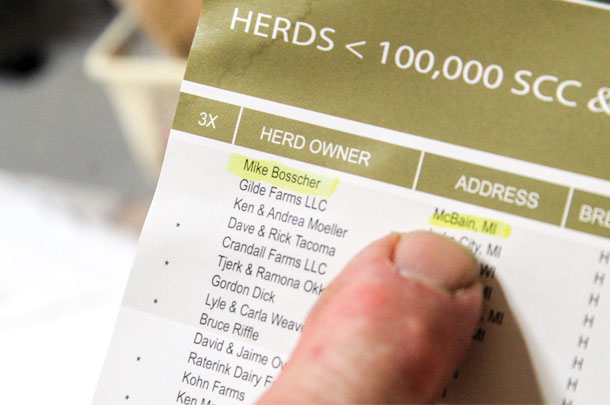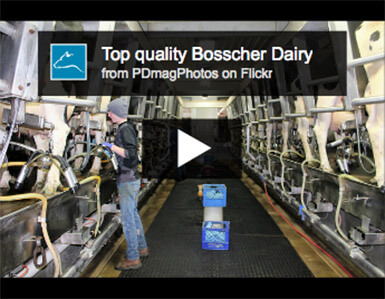Travel north on U.S. 131 through Michigan’s mitten. In the rear-view mirror lie fertile fields and expansive farms. Ahead lie timber, hunters’ paradise and Michigan’s playground of forests, lakes and outdoor sports.
But a detour to the tiny town of McBain in Missaukee County reveals a pocket of some of the state’s finest dairy farms hidden behind the timber. When lumber barons took the last desirable log from the area just over 100 years ago, Dutch settlers moved in, bringing with them their dairy cattle and raising forages on slopes left open from logging.
A large infrastructure of dairy-related businesses grew to support the industry, which remains strong even today.
“There are a lot of good dairy farmers in this area,” says Mike Bosscher, owner of Bosscher Dairy since 1993. He and his father, Don, farmed in partnership for 21 years prior to Don’s retirement.
With 270 cows on test and roughly 240 milking at any given time, Bosscher’s farm is small compared to some that have transformed through multiple expansions in a short time to survive and bring in new generations of dairy farmers. In many ways, Bosscher’s farm flies under the radar, maintaining a consistent herd size for 10 years.
When it comes to quality milk, however, the Bosscher farm is a standout among standouts, earning the top spot on Northstar’s Performance Summary report for Michigan, Ohio, Indiana and Wisconsin last year.
“To be honest, it wasn’t my goal; the goal is produce the highest-quality milk we can all the time,” says Joe Kulhawick, herd manager for the past 20 years. Ten other herds from the area find a spot on the top 100 list, with several in the top 10, a statement for the quality and depth of the area’s dairy industry.
For the past five years, Kulhawick has been solely responsible for herd management decisions and has an ownership interest in the herd. His wife, Ruth, feeds calves and fills in anywhere a need arises.
There is no magic bullet, no one key component to achieving a somatic cell count score averaging 55,000 over a one-year period. Rather it is an entire system, built around a key component: people.
Josh Coates and Zach Podbilski are full-time employees and the main milking crew for the past three years. They are assisted by three additional part-time high school student employees and full-time employee Joe Kulhawick. All are trained by Ruth and Joe.

Yesterday’s somatic cell count and quality information are printed and posted at the time clock daily. “It helps us stay accountable to each other,” says Coates, a U.S. Army veteran and local college student. Each employee also receives the report daily via email.
Milking is done in a double-12 parlor with automatic take-offs by two people twice per day and takes about two-and-a-half hours. Cows are prepped in groups of three. “We bottle brush to remove sand from udders, dip teats with iodine and make sure we get enough on, strip and wipe off with a clean towel,” says Podbilski, 21.
The iodine solution, Icon 5000, stays on for one minute. Cows are post-dipped with the same product unless the temperatures drop below 20ºF, when a substitute dry powder is used.
Bosscher, his step-son, Tyler Scholten, and a crew of additional full-time and seasonal employees raise and store quality feed. Surplus forage has become a consistent revenue stream for the farm, which supplies some neighbors in addition to their own needs from Bosscher’s 1,200 acres.
“It’s really about the people,” Kulhawick says. “People are [who] put up quality feed. We don’t lose calves; treating cattle is not profitable. People take the rake and scrape freestalls. Yes, there’s management to do, but that’s all a people thing.”
“Joe gets dirty with the rest of them, and that speaks volumes,” Bosscher says.
Cattle are not treated for mastitis. Rather, if a problem is due to bruising, flares are cleared with a couple days of hypertonic saline administered as IV to promote water consumption and a body flush, paired with udder mint to remove swelling. The milk is discarded.
Freestalls are bedded every seven to 10 days, and heifer barns cleaned three times per week, depending on animal size and weather conditions. Fifty yards of sand arrive at the farm almost weekly, and the farm uses about 250 round straw bales yearly.
Genetic selection has made the job of producing clean milk just one step easier. Kulhawick looks at both cow families and bulls. “My sire selection has never been just about milk,” he says. “It is about functional type – feet, legs and udders; you have to have that first. If a bull is +2000 on Milk but poor on Composite, I won’t even look at him.” High repeatability is a must.
See photos from Bosscher Dairy.
Kulhawick believes poor feet and legs are an unspoken thief lurking in the barn. “Although nobody talks about it, I will argue the fact that it will affect milk quality. Kicking her bag side to side is not good.” Joe selects bulls the farm will use; ABS provides mating and breeding services.
When heifer prices are high, the farm sells up to 30 springers annually to a list of repeat customers. At today’s heifer market, Joe prefers to keep genetics within the herd.
Stockmanship and low stress are key in all cattle handling. Cattle are not chased to and from the parlor but, rather, the gates are opened and the cattle move willingly to the barn. Shouting, whistling, loud noises and rough handling are taboo.
The herd averages 85 pounds of milk per cow per day with 4 percent butterfat and 3 percent protein. “Yes, we could get a lot more milk if we wanted to,” Joe says. However, both owner and herdsman agree pushing cows to 3X milking results in higher production costs for labor, equipment maintenance, electric, soap, sanitizer, feed and less Productive Life per cow, than it’s worth.
“It’s the little things that come together. Some people are doing it to say they get 100 pounds of milk per cow, and I’m not sure if they know where their breakeven point really is,” Bosscher says. “At the end of the day, we have to try to be profitable.”
Kulhawick’s top five priorities when it comes to producing quality milk include:
- Each part of the equipment from extraction to cooling and storage must be in perfect working condition always.
- Cleanliness throughout the entire operation, not just the milk house
- Thoroughly trained employees
- Strict rules of stockmanship
- Employees led by example
Cash for employee quality incentives is scarce these days; however, Ruth says, “The guys get a lot of pizza and donuts.” They also get a lot of praise and weekly feedback which is not focused on negatives.
As a reward for the achievement, Zack and Josh each own a feeder steer at the farm and will receive a check for that animal once it is finished and sold.
“There are days when I’m not popular because I’m fussy and it’s gotta be done right,” Kulhawick says. “But the guys know what’s expected, and these are good guys to have around. I tell them, ‘It’s not a race. Let’s see how good a job we can do in a reasonable time to do it.’”
Although their true mission is unwritten, management, ownership and labor agree. “It’s not just about ourselves at the end of the day; everything we do here, we work for the Lord,” Kulhawick says. ![]()
PHOTO 1: The cow management and milking team is focused on milk quality every day. The result is an award winning team. Pictured from left: Josh Coates, Zach Podbilski, Joseph, Joe and Ruth Kulhawick.
PHOTO 2: Bosscher Dairy earned the top spot on Northstar’s Performance Summary report for Michigan, Ohio, Indiana and Wisconsin last year, with a somatic cell count average of 55,000. Photos by Bev Berens.
Bev Berens is a freelance writer in Holland, Michigan.






